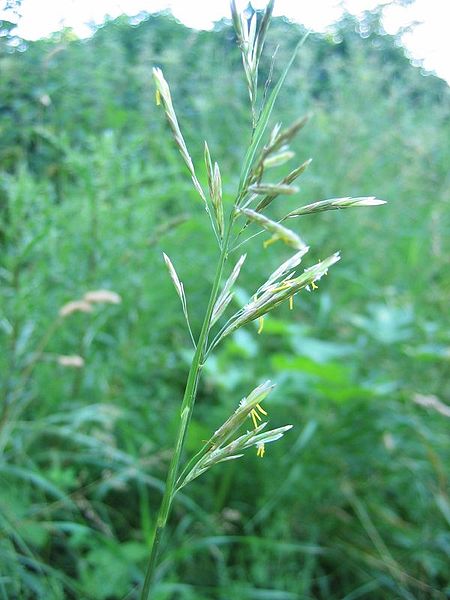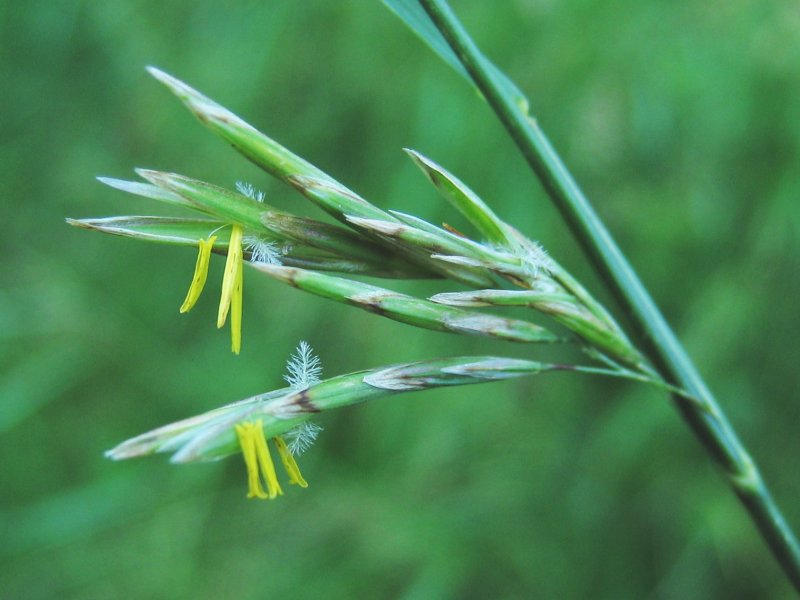 |
|
http://commons.wikimedia.org/wiki/User:Fabelfroh |
 |
| http://commons.wikimedia.org/wiki/User:Fabelfroh |
Translate this page:
Summary
Physical Characteristics

 Bromus inermis is a PERENNIAL growing to 1.2 m (4ft).
Bromus inermis is a PERENNIAL growing to 1.2 m (4ft).
See above for USDA hardiness. It is hardy to UK zone 3. It is in flower in May, and the seeds ripen from August to September. The species is hermaphrodite (has both male and female organs) and is pollinated by Wind.
Suitable for: light (sandy), medium (loamy) and heavy (clay) soils. Suitable pH: mildly acid, neutral and basic (mildly alkaline) soils. It can grow in semi-shade (light woodland) or no shade. It prefers dry or moist soil.
UK Hardiness Map
US Hardiness Map
Synonyms
Bromopsis inermis (Leyss.) Holub. Bromus erectus Ledeb. [Invalid]. Bromus glabrescens Honda.
Plant Habitats
Meadow; Cultivated Beds;
Edible Uses
References More on Edible Uses
Medicinal Uses
Plants For A Future can not take any responsibility for any adverse effects from the use of plants. Always seek advice from a professional before using a plant medicinally.
None known
References More on Medicinal Uses
The Bookshop: Edible Plant Books
Our Latest books on Perennial Plants For Food Forests and Permaculture Gardens in paperback or digital formats.

Edible Tropical Plants
Food Forest Plants for Hotter Conditions: 250+ Plants For Tropical Food Forests & Permaculture Gardens.
More

Edible Temperate Plants
Plants for Your Food Forest: 500 Plants for Temperate Food Forests & Permaculture Gardens.
More

More Books
PFAF have eight books available in paperback and digital formats. Browse the shop for more information.
Shop Now
Other Uses
Soil stabilization
An excellent plant to grow for controlling soil erosion because of its fast-growing interlocking root system[269]. It is especially valuable in semi-arid regions, such as the Prairie Provinces of Canada and the Great Plains of the United States[269]. Growth starts early in spring with a further period of growth in early autumn under favourable moisture conditions[269].
Special Uses
References More on Other Uses
Cultivation details
Best adapted to regions with moderate rainfall and moderate cool summer temperatures, it is suited to silt or clay soils and deep loams, but also does well on light sandy soils and on well-drained soils. Plants are less drought resistant than crested wheatgrass and they do not tolerate temperature extremes. Smooth brome is suited for irrigated areas but is not recommended for saline or alkali soils[269]. Smooth brome is reported to tolerate an annual precipitation of 32 to 176cm, an annual average temperature range of 4.3 to 19.9°C and a pH in the range of 4.9 to 8.2[269]. Smooth brome is also reported to tolerate alkali conditions, disease, drought, frost, fungi, grazing, mycobacterium, salt, viruses, and weeds[269].. There are a number of named varieties, selected mainly as hay and pasture crops. These cultivars are divided into two groups, northern and southern. The southern group is less cold-hardy and does not survive average winter conditions further north than southern Minnesota in N. America, the northern group is much more cold tolerant[269]. The genus Bromus contains many complex, polyploid series. Bromus inermis belongs to section Bromopsis, containing wild species with chromosome numbers ranging from 2x to 8x. Following its introduction to North America, smooth broome, an aggressive species, has tended to replace native American species of sect. Bromopsis, especially B. pumpellianus. Hybridization studies have been made between: B. inermis, 8x; B. pumpellianus, 8x; and material of the introduced B. erectus complex (6x, 8x, 10x, though the last is probably itself hybrid). An objective of these studies was to incorporate into inermis the larger seeds of pumpellianus and better seedling vigour of erectus. The three species are related, crossable and give quite fertile hybrids. Collections of B. inermis in North America show varying meiotic irregularity and aneuploidy. This is probably a result of introgression from B. pumpellianus and the B. erectus complex. Quite a high degree of meiotic irregularity may be tolerated under natural conditions in a long lived, cross- pollinated species such as B. inermis, which can spread aggressively by rhizomes[269].
References Carbon Farming Information and Carbon Sequestration Information
Temperature Converter
Type a value in the Celsius field to convert the value to Fahrenheit:
Fahrenheit:
The PFAF Bookshop
Plants For A Future have a number of books available in paperback and digital form. Book titles include Edible Plants, Edible Perennials, Edible Trees,Edible Shrubs, Woodland Gardening, and Temperate Food Forest Plants. Our new book is Food Forest Plants For Hotter Conditions (Tropical and Sub-Tropical).
Shop Now
Plant Propagation
Seed - sow spring in situ. The seedbed should be firm and seed should not be covered to more than 6 - 13 mm depth. Seed rates of 3.3 kilos per hectare are used when the plant is sown in a pure stand, though it is more often sown in a mixture with various legumes such as alfalfa, sweet clover, red clover or Lotus corniculatus[269]. There are approximately 300,000 seeds per kilo[269].
Other Names
If available other names are mentioned here
Arctic brome, Pumpelly's brome (subsp. pumpellianus), Austrian bromegrass, Russian bromegrass, awnless brome, Hungarian brome, Hungarian bromegrass, smooth brome, smooth bromegrass, (subsp. inermis). French: brome inerme, brome sans arêtes. German: unbegrannte Trespe, wehrlose Trespe. Portuguese: capim-cevadilha. Spanish: bromo de Hungría.
Native Range
TEMPERATE ASIA: Turkey, Russian Federation-Ciscaucasia (Ciscaucasia), Armenia, Azerbaijan, Georgia, Russian Federation (Dagestan), Russian Federation-Western Siberia (Western Siberia), Russian Federation-Eastern Siberia (Eastern Siberia), Kazakhstan, Kyrgyzstan, Tajikistan, Turkmenistan, Russian Federation-Far East (Far East), China, Japan (Hokkaidô, Honshu, Kyushu, Shikoku) EUROPE: Austria, Czech Republic, Germany, Hungary, Netherlands, Poland, Slovakia, Russian Federation (European part), Belarus, Moldova, Ukraine (incl. Krym), Bulgaria, Croatia, Italy, Romania, Serbia, Slovenia, France
Weed Potential
Right plant wrong place. We are currently updating this section.
Please note that a plant may be invasive in one area but may not in your area so it's worth checking.
This plant can be weedy or invasive.
Conservation Status
IUCN Red List of Threatened Plants Status : This taxon has not yet been assessed.

Growth: S = slow M = medium F = fast. Soil: L = light (sandy) M = medium H = heavy (clay). pH: A = acid N = neutral B = basic (alkaline). Shade: F = full shade S = semi-shade N = no shade. Moisture: D = dry M = Moist We = wet Wa = water.
Now available:
Food Forest Plants for Mediterranean Conditions
350+ Perennial Plants For Mediterranean and Drier Food Forests and Permaculture Gardens.
[Paperback and eBook]
This is the third in Plants For A Future's series of plant guides for food forests tailored to
specific climate zones. Following volumes on temperate and tropical ecosystems, this book focuses
on species suited to Mediterranean conditions—regions with hot, dry summers and cool, wet winters,
often facing the added challenge of climate change.
Read More
Expert comment
Author
Leyss.
Botanical References
Links / References
For a list of references used on this page please go here
Readers comment
© 2010, Plants For A Future. Plants For A Future is a charitable company limited by guarantee, registered in England and Wales. Charity No. 1057719, Company No. 3204567.